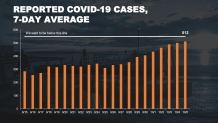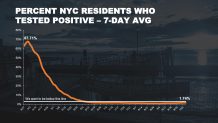What to Know
- Gov. Andrew Cuomo unveiled a sweeping slate of new restrictions for cluster zones, color-coding them 'red,' 'orange' or 'yellow' by risk; red areas see total shutdowns. The rules are in effect for at least 14 days
- Schools in the orange zones must also switch all-remote and gyms and personal care businesses are closed; they can remain open in yellow zone areas but mandatory weekly testing applies for schools
- While Cuomo's mapped zones are less geographically encompassing than the ZIP code shutdowns Mayor de Blasio had proposed, they heavily impact Orthodox communities, which are protesting
UPDATE: New NY Restrictions Take Effect, NJ Hints at Tighter Rules to Come as Hospitalizations Soar
Parts of New York, including areas of Brooklyn and Queens, will see their most severe COVID restrictions in months resume Thursday, Mayor Bill de Blasio said, with nonessential businesses closed and mass gatherings banned in state-identified cluster zones that have seen positivity rates soar over the last month.
De Blasio warned heavy fines -- up to $15,000 a day for violating the rules on mass gatherings and up to $1,000 a day for social distancing and mask violations -- will be issued as officials work to contain the worst outbreak in months.
There are three different levels of restrictions, according to the color-coded maps unveiled Tuesday by Gov. Andrew Cuomo's office. The highest-risk areas are colored red, surrounding areas in orange and precautionary spots in yellow. Schools in the red zones were closed earlier this week by Cuomo, while schools in the orange zones will switch all-remote Thursday, de Blasio said. Those shaded yellow can remain open to in-person learning but must conduct weekly testing.
The United Federation of Teachers, the city's rank-and-file teacher's union, said 124 schools across 153 locations will now have to go all-remote on Thursday. That includes 33 more schools than an initial shutdown proposed by Mayor de Blasio over the weekend. 308 other schools were in the yellow zone requiring weekly testing.
Are you in a cluster zone? Here are all the maps -- and a quick guide to the rules
De Blasio noted that Crown Heights and Williamsburg, areas the city has been carefully tracking, are not within the state's cluster zones. He said the city would continue to monitor those areas and focus on outreach and enforcement.
De Blasio said the city would develop a searchable tool by address to help people determine in which, if any, cluster zone they reside.
It's not clear how long the new restrictions could last. They're likely to remain in place for a minimum of 14 days but could stick for a month or longer depending on community compliance and trends in COVID positivity rates.
In his briefing Wednesday, de Blasio said the city has a tough few weeks ahead, but urged New Yorkers to come together to address the outbreak head on.
"It's up to all of us," the mayor said. "It will take hard work and discipline and certainly there will be sacrifice. I feel for everyone in the communities who will be affected. If we act quickly and decisively we can overcome this for all of us, for the whole city. We need to stop this outbreak dead in its tracks."
Cluster maps were also drawn for parts of Orange and Rockland counties that have seen extensive COVID upticks in recent weeks, so much so that they, along with the ones in the city, are driving up numbers statewide: Hospitalizations hit their highest total Tuesday since July 22 (705). The positivity rate is also up.
As of Wednesday, the overall positivity rate for the 20 hotspot ZIP codes was 5.1 percent (Brooklyn - 2.2%; Orange County -- 3.9%; Rockland County -- 4.5%; Broom County -- 6.1%), Cuomo said. The statewide infection rate hit 1.25 percent; without the hotspot areas, it would be around 1.05 percent, the governor said.
Those 20 ZIP codes have accounted for 20 percent of all new hospital admissions over the last two weeks, and the same share of all positive cases statewide Tuesday, despite representing just 6.7 percent of the state's population.
'Cluster Action Initiative' Controversy
While the full restrictions have yet to go into effect, some business owners, parents and worshippers are already pushing back on Cuomo's self-dubbed "Cluster Action Initiative," which heavily encompasses Orthodox communities.
Some members of those communities say they're being unfairly targeted. Dozens of community members took to the streets in Borough Park, one of the nine mayorally identified city hotspots, Tuesday night to protest the state's plan. At one point, a fire erupted in a crosswalk. Some people tossed masks into the flames.
De Blasio addressed some of the protests Wednesday, saying he understood people opposed the new restrictions and they have the right to feel the way they do. But, he said, the city won't tolerate setting fires or assaults on police officers. If that happens, he warned there would be consequences.
Parents are also concerned. By Cuomo's ruleset, schools in yellow zones can stay open but students and staff must be randomly tested on a weekly basis. De Blasio encouraged parents Tuesday to sign consent forms for their kids, while Catholic schools in various parts of the state are threatening to sue the governor.
The state and city are still working to finalize the cluster zone maps, and Cuomo said the state would take the lead on enforcement in the highest risk areas, though localities will be required to provide personnel to assist with those efforts. New York City has to contribute about 400 people to the state task force.
Daily Percentage of Positive Tests by New York Region
Gov. Andrew Cuomo breaks the state into 10 regions for testing purposes and tracks positivity rates to identify potential hotspots. Here's the latest tracking data by region and for the five boroughs. For the latest county-level results statewide, click here
Source: ny.gov
The Writing on the Wall
To those who are frustrated by the impending slate of restrictions, Cuomo said Tuesday, "There is no one who can say they didn't see this coming."
De Blasio initially proposed a shutdown plan for nine hotspot ZIP codes to the state on Sunday. He wanted full COVID restrictions reinstated in those areas by Wednesday and was keeping an eye on what became a growing number of ZIP codes on the city's watchlist. De Blasio added a 13th ZIP code to that list Tuesday as the city's daily case average topped 500 for the first time in months.
It was even higher on Wednesday.

Combined, new cases from the watchlist ZIP codes and the nine hotspots have accounted for more than 40 percent of all citywide cases over the last two weeks, officials said.
The nine hotspots alone account for a quarter of new COVID cases citywide over the last two weeks, despite representing just 7.4 percent of the population. They've seen positivity rates above 3 percent for more than seven consecutive days. Two of the watchlist ZIP codes were on the verge of the same Wednesday.

"The facts on the ground are clear. We need restrictions to stop this problem," de Blasio said in his daily briefing Tuesday. "If we all do what's right as we did before, we keep moving forward. If we do it wrong, it endangers the whole city."
The threat has become more apparent with each passing day, as the health indicators show. The city's daily average COVID caseload has risen drastically in recent weeks. Its seven-day rolling positivity rate is nearing the 2 percent threshold that de Blasio set to shutter indoor dining across all five boroughs.

Emergency departments citywide are seeing a slight uptick in visits for COVID-like illnesses over the last week, the health department said.
Health officials declined to identify specific hospitals seeing ER visits rise, though said in a statement, "With COVID19, increases in hospital visits generally follow an increase in cases. Data show we are starting to see an uptick in the number of hospitalized patients in two hospitals in Brooklyn and at least one in Queens."
As New Yorkers all too painfully learned earlier this year, more cases tend to lead to more hospitalizations, which ultimately leads to more death. According to data from Johns Hopkins University, more than 33,000 New Yorkers have died of COVID-19, more than any other state and about 16 percent of the national toll.
New York City alone has lost at least 21,000 people, including deaths that probably were caused by COVID but not definitively linked to it by diagnosis. The CDC has said another 5,000 more fatalities could be attributed to it in some way.



